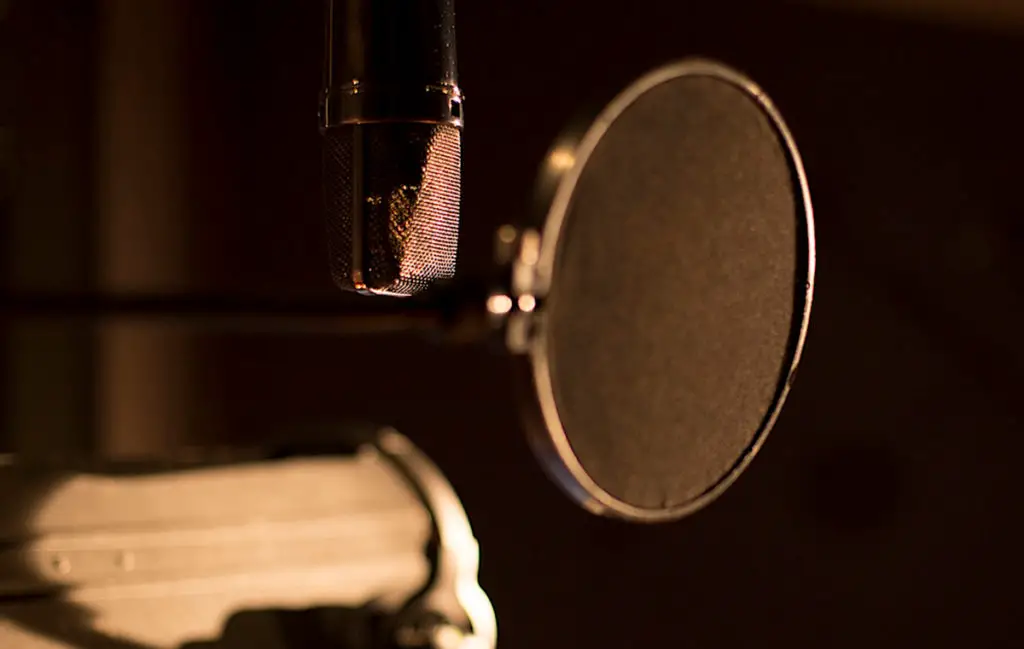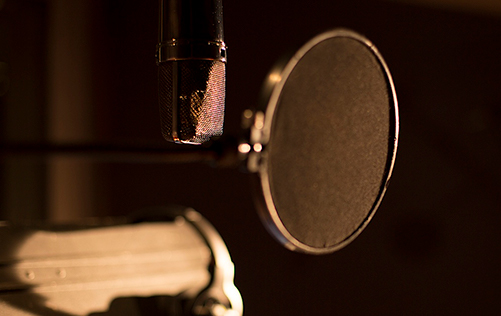Whether you’re a musician, audio actor, or podcaster, microphones aren’t always the perfect standalone device to protect your final product from unwanted noise. Sometimes, microphones need specific tools or devices to regulate unwanted noises or sounds.
You’ve probably seen a microphone pop filter before in photos, videos, a studio, maybe even a live event, but do you know what a mic pop filter is for?
A microphone pop filter is a thin mesh sheet designed to allow soundwaves to pass but reduce or eliminate air rushes from plosives. Pop filters improve the sound quality picked up by the microphone by reducing popping sounds when using certain sounds, pronunciations, or noises such as “P’s” and “B’s.”

A mic pop filter, a noise protection filter device, reduces or eliminates plosive energy associated with air from the human voice and proximity to the microphone.
It may seem that pop filters all do the same thing. In actuality, there are many design distinctions that should be considered.
As you continue to read on, you’ll learn more about pop filters, including what and how they work. I’ll also discuss how an alternative method like a sock can function as a pop filter and the difference between mic covers (windscreens) and pop filters.
Here are my recommendations:
If you need or prefer something a little bigger, go with this pop filter:
Do I Need a Pop Filter?
Have you ever been in a room with someone recording, and they sound magnificent live, but when you playback the recording, it has loud popping and thumps noises? It makes you wonder what the microphone is hearing that our live ears are not.
Do you need a microphone pop filter?
Microphone pop filters are needed for the best audio quality when speaking or singing directory into the microphone, especially a condenser mic. A good pop filter will remove plosives without filtering out higher sound frequencies. Pop filters are only intended to be used indoors, such as in a studio setting.
It’s worth noting that many mics have a pop filter built-in, in particular live vocal mics such as the SM58. Such filters generally don’t work as well as a proper external lollipop screen, meaning they take away more treble.
Back to the noises. It turns out that these noises occur mainly on what are known as ‘plosive’ sounds. A plosive sound creates an air explosion from the mouth, translating into a loud, low-frequency thumping sound through a microphone.
A mic pop filter will come into play for the user to eliminate or reduce plosive sounds from a recording. Prime examples are words that start with harsher consonants like P, B, T, D, K, and G. We tend to expel a blast of air and make unwanted sounds like hissing when we speak.
It can eliminate most popping sounds when you use certain words or make noises while talking close to the microphone, like breathless laughs, hissing while talking, etc.
Pop filters improve sound quality in your audio recordings by reducing the air pressure to prevent popping sounds from reaching the microphone’s diaphragm. Pop filters also help keep the microphone safe from saliva.
Check out this video to see how an audio recording sounds with a mic pop filter versus without one:
Do I Need a Pop Filter if I Have a Mic Cover?
Many people who record musical or vocal audio tend to question if they need a mic pop filter, mic cover, or both.
A pop filter is unnecessary when using a mic cover or windscreen. The two tools can be used interchangeably depending on your setting and application. A mic cover usually dampens higher frequencies more than a pop filter.
While mic covers and mic pop filters are essential for helping you improve the audio quality of your recording by reducing or eliminating plosive sounds, mic covers can protect your mic from the wind.
Windscreens are usually made from a foam material and are designed to fit snugly over the microphone element casing.
Mics are sensitive to wind. When recording audio on a bare microphone, you might get a recording where your voice is inaudible due to wind. Mic covers fit around the microphone to protect the mic capsule from the windblast.
Pop filters usually consist of acoustically transparent foam and/or mesh and work by being placed in front of the microphone element. A pop filter doesn’t protect the microphone from the wind like a mic cover.
To reduce wind current, breath blasts, and vocal plosives, mic covers and pop filters are excellent, and it’s what they were made to do. Mic covers and pop filters are standard tools that people utilize.
Pop filters are commonly used for recording vocals in a studio setting.
Mic covers protect from wind and don’t need to be used indoors. Especially since most dynamic microphones have windscreens built into the element casing already.
Related Content: What’s The Difference Between Dynamic And Condenser Microphones?
What Does Putting a Sock on a Microphone Do?
When it comes to producing a recording for the first time, you may find that it isn’t as easy as your favorite audio announcers, musicians, or even podcasters make it seem.
In a pinch, they will save money on equipment to produce the final product, including homemade options such as a pop filter. Pop filters come in handy with your audio needs, including vocal recording or podcasting.
Some of them may use a sock as a substitute pop filter.
Putting a sock on a microphone allows you to filter plosive sounds as a pop filter would, but also muffles the sound by removing high frequencies.
But hey, using a sock may save you some money because you can use one you already have around the house.
Check out this video to see how and why you might use a sock as a pop filter:
Although a sock is easy to set up and cost-efficient, it does have its downsides as it does not work as well as professional pop filters. You may find that you need to speak louder to get the microphone to pick up on your voice.
Does a Windscreen Work as a Pop Filter?
Pop screens and windscreens get confused all the time.
Windscreens, also known as mic covers, are usually made from foam and designed to fit snugly over the microphone element casing. A pop filter is a small screen placed between the vocalist and the microphone. It does not encompass the microphone like a pop filter.
Knowing this, you are probably still asking: Does a windscreen work the same as a pop filter?
Windscreens have similar functions as a pop filter but do not replace the use of a pop filter. A pop filter diverts the vocalist’s plosive energy and wind gusts without reducing high frequencies. A windscreen blocks all ambient wind, isn’t as effective against plosive sounds, and tends to dampen high frequencies.
The primary purpose of a windscreen is to protect the capsule from windblasts. Such foam windscreens, thus, are mainly designed for (open-air) stage use and field recording.
Windscreens look like they should be a reasonable means of protection, but they usually aren’t. It’s not what they are designed for.
Pop filters are much more effective against plosive noises than windscreens.
The Verdict
A pop filter reduces the energy of plosives as you sing or talk; and will save your recording from retakes. Without a pop filter, plosive sounds would be hard to fix in the editing room and could ruin your final product.
Consider investing in a reliable pop filter if you know that you’ll be recording a lot in the studio or at home. A pop filter will protect your final product from plosive or popping sounds and may even help your mic last longer.
The filters have a hygienic function to protect your microphone element against the accumulation of saliva that can erode your mic over time. A pop filter will effectively improve your microphone’s lifespan.


